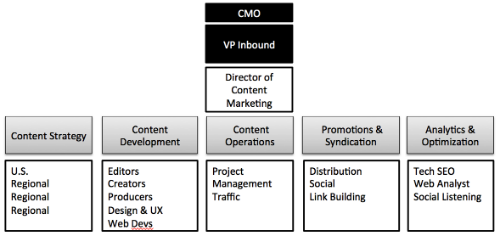 If you had to bet your job on it, do you feel you could predict the future of content for your organization in the next 12 months? How about in the next 3 years?
If you had to bet your job on it, do you feel you could predict the future of content for your organization in the next 12 months? How about in the next 3 years?
The technologies behind the search and social web along with consumer behaviors are changing so fast, it’s a real challenge to anticipate with certainty what exact form content will take in the future. But one thing is certain, the importance of content for brands will be more important, more pervasive and decidedly more competitive.
So what questions can we answer about content over the next 1 to 3 years? I think one of the most important starting points is a consensus within your organization’s leadership as to what content really is, why it matters to customers and the role content will play in advancing business goals.
As organizations mature their understanding of content marketing, they’ll also need to structure themselves for scalable, meaningful content and determine what tools or platforms they should plan for to support that growth. This post will touch on each of these 3 areas.
What is Content Anyway?
A few months ago I did an informal poll on Twitter, Facebook and Google+ asking our network “what is content?” The responses I received were really interesting and could essentially be organized into 3 groups:
1. Content = things, objects, or tangibles like text, images, audio, video
2. Content = means to create experiences, value creation, or outcomes
3. Content = too ambiguous to define
Too ambiguous but also too important – Taken more philosophically, maybe the idea of content is too broad to define. But today’s organizations simply don’t have that luxury. Maintaining the status quo isn’t going to buy time to better understand where content fits in the marketing mix. The technologies evolving behind the search and social web are moving too fast and in many cases, increasingly disruptive to traditional content publishing models.
Content Marketing maturity – While both BtoC and BtoB companies are investing more in content, those that are still in early stages of Content Marketing maturity see content as a tactic. The approach is often focused simply on creating more content in the hopes of casting a wider net and in some cases, optimizing content performance based on analytics.
Welcome to the content experience – Content is a a means towards attracting, engaging and persuading customers, employees, media, industry and any other audience the brand is trying to reach. Content is a vehicle for creating experiences and customers increasingly expect those experiences. Heck, customers are creating content experiences themselves and some have achieved community growth and reach that rival mid-market brands.
Content Marketing is more than brands being useful, it’s about connecting with communities in a meaningful way, often at an emotional level. Mastering the ability to create those experiences can be your competitive advantage.
What About Social Content Disruption? From blogging, to YouTube videos to Vine and Instagram – social publishing and networking platforms are innovating content faster and with more creativity than any brand could ever hope to achieve on it’s own.
From borrowing inspiration from YouTube videos to create broadcast TV commercials to major news outlets adopting blogging as a publishing platform the changes occurring with content publishing are transformational with much more to come.
Future empowerment to publish and connect at scale is in the hands of the people and communities on the search and social web. Brands are less in control, and more like guests on these emerging platforms. Those brands that continue to push without participating will find their content falling on deaf ears. Brands that engage and co-create content with vibrant social communities will find momentum to attract, engage and convert content experiences into business growth and revenue.
Using a customer centric model that anticipates, implements and optimizes content according to how target audiences Discover, Consume and Act on information, companies can build a phased approach to content marketing maturity. Identifying topics that resonate, distribution and social channels where brand content can connect and the offers that motivate engagement, sharing and transactions can all come together with an evolved Content Marketing strategy. As content is refined and communities are engaged, content marketing performance can be optimized both creatively and technically.
The role of big data, structured data, sponsored content, mobile content and omni-channel or multi-channel integration are all opportunities to be explored as part of defining the future of content in your organization. But where to start and how do you organize it?
Structuring Organizations for Content Success
This year in the U.S., time spent with digital channels with surpass TV for the first time (eMarketer) and smartphone sales have surpassed computers for a few years already (Canalys). Understanding how content is discovered, consumed and why it’s acted on affect content marketing strategy as well as how content marketing fits in your organization.
There’s an entire book by Joe Pulizzi and Robert Rose dedicated to organizing and managing for content marketing success, so be sure to check it out.
For a large corporation, there are varying structures, but one example has content marketing within the Inbound organization with a centralized team for strategy, development, operations, promotion/amplification, listening and analytics.

An argument could be made for a hybrid model too, where there is some centralized focus on strategy and some production and analytics, but development and amplification occur largely at the regional level. In both cases, there’s room for external agency support, especially in certain areas of content production, amplification and performance optimization.
For an agency, things might look a bit differently, with “pods” centered around a content strategist and implementation teams focused on a certain book of clients.

The thing to figure out for your organization is at what level of content maturity are you and what plan you have in place to approach transitioning from wherever you are, to where you want to be – then structure accordingly.
Early stage companies would focus more on core planning and creation, whereas mid stage companies would evolve internal and external content participation with subject matter experts and their community. Late state companies are essentially publishers that can monetize their content capabilities in several ways beyond customer acquisition and branding.
Content Marketing Tools of the Future
A blog, HootSuite and Google Anlaytics can help a fledgling content marketer get started, but to be competitive and to scale will require more and different tools.
What content marketing tools should you consider? Content Management Systems, blogging platforms, content amplification, syndication, optimization, measurement, listening, community engagement, social media management, marketing automation, (big) data analytics, email, social networking, mobile, ad platforms, media creation and asset management – there are many tools and platforms that can help a business scale their content marketing efforts.
Fundamentally, tools and platforms that facilitate content planning, creation, amplification, measurement and performance optimization are going to be as relevant in a few years as they are now. Certainly many tools themselves will change, but these are the categories of tools that companies would do well to focus on and gain expertise.
In the end, tools are only as effective as the expertise of the people using them, so gaining organizational competency and mastery with these core types of content marketing tools is essential for being able to scale, adapt and remain competitive.
So here’s the punch line of this post:
Right after Jay Baer gives his opening keynote (but before William Shatner gives his) I’m going to be presenting on this very topic in 3 weeks at Content Marketing World – the largest and many say “best” conference on the topic.
I’ll be sharing the big picture trends of course, especially when it comes to integrating content with search and social media optimization. I will also share specific and practical examples of how companies are organizing their content marketing teams and some of the search, social and content marketing integration tools that will help put your plans, teams and strategies into action for the future.
I hope to see you there!
Details:
Content Marketing World
Cleveland, OH Sep 9-12
The Future of Content on the Search and Social Web
Sept 10th: 9:45 AM – 10:30 AM
Image source: Shutterstock


